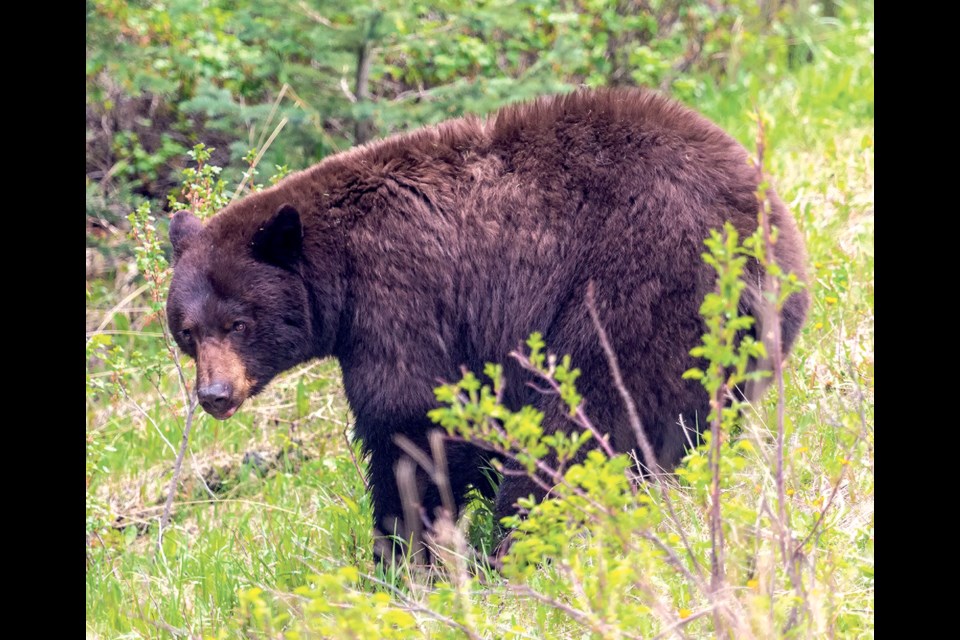BANFF NATIONAL PARK – A black bear previously radio-collared and subjected to successful aversive conditioning after it accessed human food in 2017 is the reason for a warning currently in place for Lake Minnewanka Loop in Banff National Park.
On Aug. 21, the cinnamon-coloured black bear – a mature female – accessed the contents of a “full cooler” in the Two Jack Lake area, according to Parks Canada. The bear’s home range is known to include Lake Minnewanka and Two Jack Lake, and this is the first human conflict it had in about six years.
“She returned to natural behaviours and, despite the core of her home range falling in a very high-human-use area, had not come into conflict with people again until the incident in question,” said Emma Badgery, Banff field unit public relations and communications officer, in an email.
“It’s important to note that Parks Canada believes this bear did not actively seek out the food she accessed at Two Jack Lake; rather this was most likely an unfortunate incident of opportunity.”
Badgery said the cooler belonged to a party of two picnickers who were sitting near the lakeshore between the Two Jack Lake Campground and Day Use Area when the bear passed by.
“Seeing the bear, the individuals fled, and the bear took advantage of their departure to access a substantial food reward from the cooler,” she said. “Parks Canada investigated and at this time no charges are pending.”
Parks is closely monitoring the situation and actively working to radio collar the bear once again, she added.
Once collared, Parks Canada wildlife staff will be able to track the bear’s location and begin further aversive conditioning. The bear will be proactively hazed away from areas frequented by the public in an effort to restore its instinctual caution around humans, which can wane when a bear accesses an unnatural food reward.
The bear accessed food under similar circumstances in 2017, said Badgery, but responded well to aversion tactics.
“Based on the bear’s current response to hazing and excellent body condition, the probability of aversive conditioning being successful is believed to be high at this time,” she said.
The goal of aversive condition is to teach bears to avoid people and techniques can modify unwanted bear behaviour so animals don’t need to be trapped, relocated or euthanized.
Non-lethal tools, such as rubber bullets and bear spray, are used to reinforce this message.
This negative experience can prevent habituation and reduce the chance that bears will learn to seek out food sources near people. But it doesn’t always work.
“While aversive conditioning is often an effective tool to re-teach bears wariness of humans and to keep both humans and bears safe, it is not always successful,” said Badgery. “Preventing food conditioning is always preferable to more reactive measures for managing human-wildlife conflict.”
The bear warning is in place for the area between Two Jack Lake and Lake Minnewanka until further notice. The warning excludes Cascade Ponds and Johnson Lake.
In Kananaskis Country, bear warnings are in place for Bow River Campground, Bow Valley Campground, Whitefish Day Use Area and nearby trails, and Lac des Arcs Campground, Chester Lake Day Use Area and surrounding trails, Mount Kidd RV Park and residence area, Ribbon Lake area, Heart Creek Trail and McGillivray Bunker Trail, Burstall and Hogarth Lakes, and others.
Fish and Wildlife officer Aaron Szott said there’s also been many reports of bear sightings around Canmore as of late.
“We do have bear reports of mainly black bears in and around the Canmore townsite here and those have been seen eating mainly buffaloberries and other natural food sources,” he said. “There have also been a few reports of black bears getting into fruit-bearing trees.”
In those cases, Fish and Wildlife have been working with Canmore bylaw officers to get in touch with homeowners to remove all fruit on trees and the ground as per the Town’s bylaw, he added.
Bears are concerned with putting on as much weight as possible before winter and an unchecked crabapple or other fruit-bearing tree is an easy meal.
“Sightings at this time of year often increase and that’s due to the fact that we’re getting closer to fall and winter, so bears are looking to put on as much weight as possible and increase that calorie count,” Szott said.
Visitors should be prepared to encounter a bear at any time in the Bow Valley, he added.
“Carry your bear spray, have that bear spray accessible and know how to use it. It’s encouraged to travel in groups and if you’re walking a dog, make sure that dog’s on leash,” said Szott.
“Just be aware of your surroundings. A lot of the time bears will give you signs – you’ll see a pile of scat or you might see diggings where bears have been.”
Parks Canada reminds visitors it’s equally important to ensure wildlife attractants are properly managed to keep wildlife wild. This includes keeping a clean picnic and campsite, always storing food and all scented items in a vehicle or bear-proof locker, and leaving nothing behind.
To report a bear sighting in Canmore, call Fish and Wildlife at 310-0000 or 800-642-3800 after regular business hours.
To report a bear sighting in Banff National Park, call 403-762-1473.



